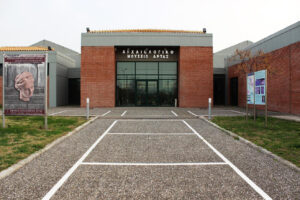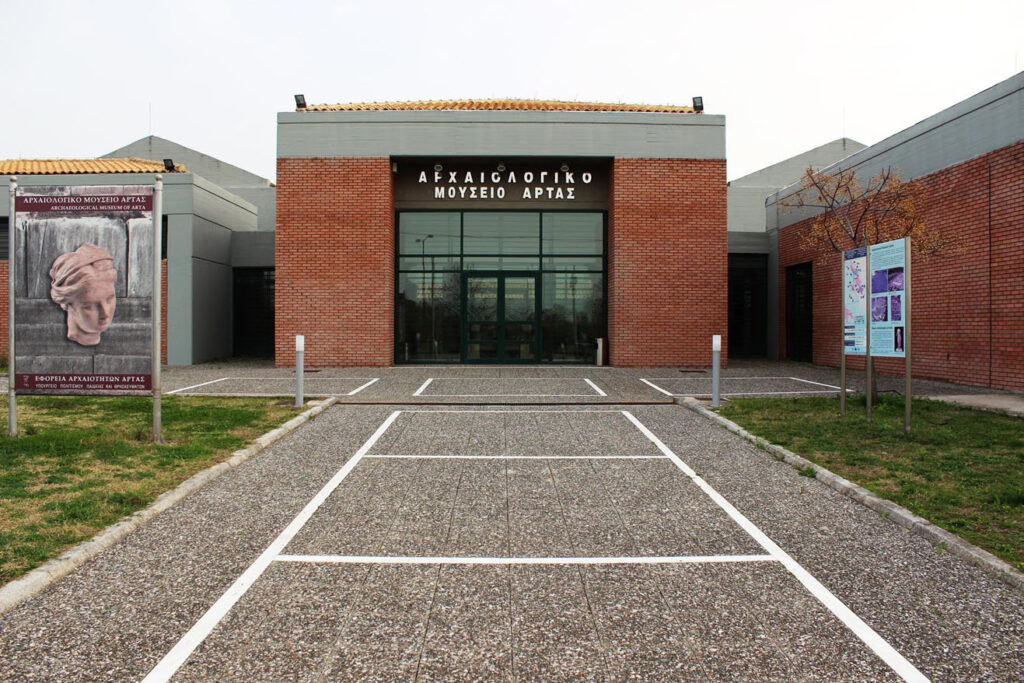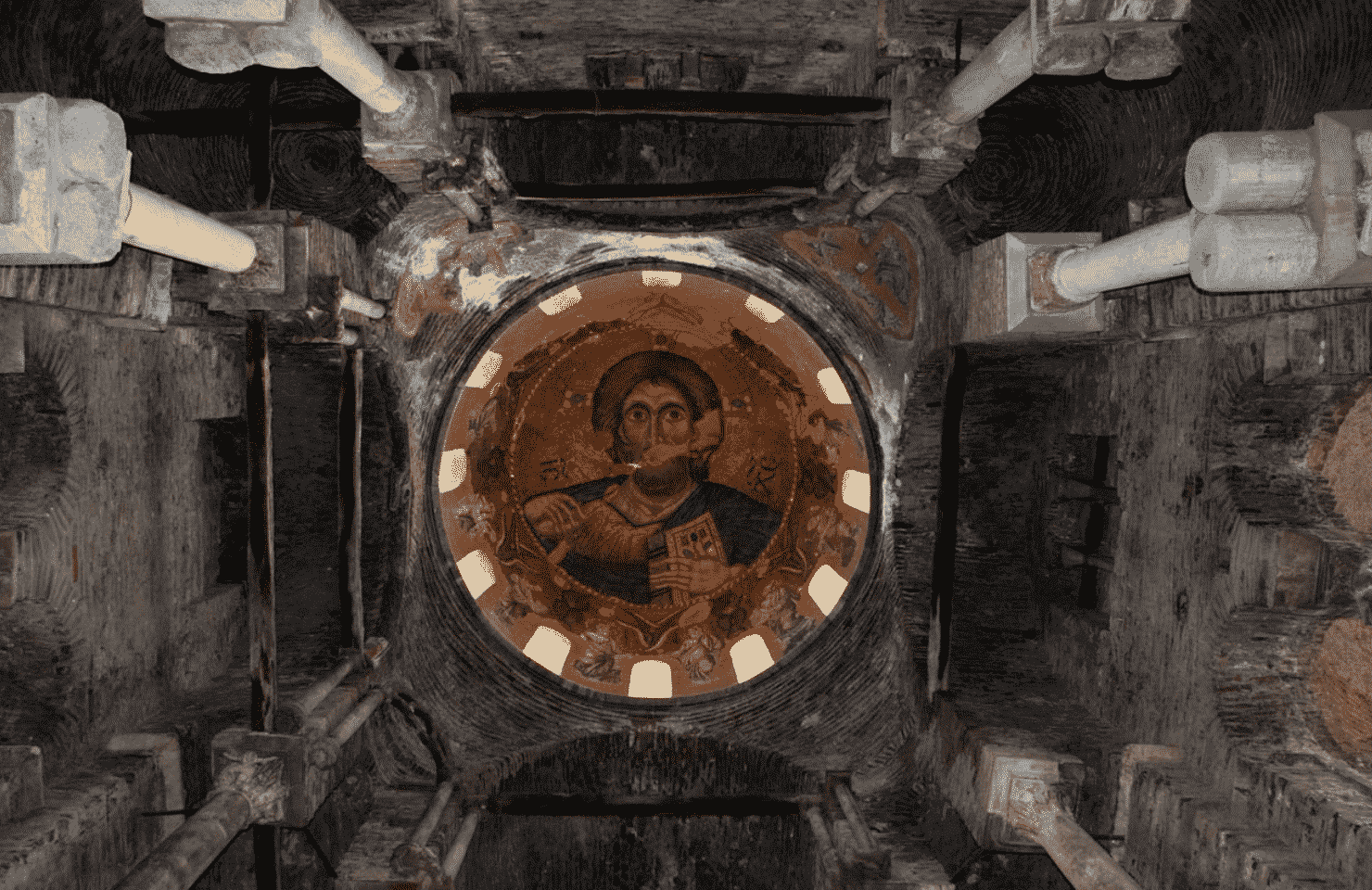First day in Arta

Very close to the legendary bridge is the Archeological Museum of Arta.It was built in 2006 and its permanent exhibition includes three big units: the public life, cemeteries and the private life of the inhabitants of Amvracia. Most of the exhibits belong to the Hellenistic times, a period that happens to be the economical and political peak of the city, as then it was the capital of the State of Epirus.

The Archaeological Museum of Arta is the place where Culture and History are combined with a modern way of displaying the “treasures” of the region. Surely, it will satisfy even the most demanding visitor.
ARTA IS A CITY YOU CAN EASILY DISCOVER ON FOOT AND ADMIRE ITS 2700 YEARS HISTORY FROM CLOSE BY. FOR YOU WHO CHOSE TO SPEND ONE DAY IN OUR CITY WE SUGGEST THE “CULTURAL ROUTE”
Then it is the Sacred Way and the Western Cemetery of Amvracia, the most important of the two cemeteries of ancient Amvracia, built along an ancient road that started from the south main gate of the city and led 20 km away to Amvracos, the harbor of the city in the Amvracian Gulf.
The Sacred Way, measuring 12 meters wide, was covered with cobblestone and had monumental tombs on both sides. In a public cenotaph one can even see the first reference of the city’s name “Anprakia”.
Continuing our journey we will meet the Byzantine Church of Panagia Parigoritissa
(Saint Mary of the Consolation).The temple was built between 1285-1289 and its size is really impressive, since the width of its sides and its height are more than 20 meters and its dome has a diameter of 7 meters.
The main dome has a unique support system, creating the illusion that it floats in the air. According to the legend the master builder and his assistant fell from the roof of the church and turned into two stones behind the church. Saint Mary appeared to the assistant’s mother, to console her for her loss and that is why the church bears this name.
Our next stop, the Ancient Theatre of Amvrakia. There used to be two theatres in Amvracia, a small and a big one, during the time of king Pyrrhus, when the city was at its best. The small theatre of Amvracia is the smallest of all the ancient Greek theatres and the only one in Epirus built within the network of a city. It was built at the end of the 4th – beginning of the 3rd century B.C. and was used until the middle of the 2nd century B.C.
On our way to the theatre we will meet the main walking boulevard in city. Here, in Skoufa Street is the heart of the city. A break for a cup of coffee or shopping will be enough to provide the energy we need to continue our trip. This area is also known for its interesting nightlife.
Last,but not least, for the most romantic our advice is “chin up”so they will admire the wonderful mansions and neoclassical houses in the city with the exquisite architecture that places Arta in other times!
A few streets and sidewalks away the road will bring us in front of
the Byzantine Church of Agia Theodora.-the patron saint of the city. The initial church was built in the 11th century A.D. and later became
a convent where Queen Theodora lived as a nun after the death of her husband and till her own end.What is particularly interesting here is the two silver coffins decorated with a relief pattern and containing the relics of Agia Theodora and the icon of the saint with silver insertion, dating from the 17th century A.D.The saint is celebrated on the 11th of March in the presence of bishops, politicians and philarmonic orchestras from all over Greece.
Close by one can find another masterpiece of Byzantine architecture – Agios Vasilios of Agora (”Saint Bazil of the Market”). The church must have been built in the second half of the 13th century, having within the same yard, from 1662 to 1821 the Manolaki School where important scholars of those times used to teach. Surrounded by houses and sidewalks, Saint Basil of Agora was an integral part of the religious life of the city, maybe a bit shadowed by the other Byzantine treasures of Arta. Nevertheless, it was always in the mind and the hearts of the city’s people and still remains one of the most important monuments of the region.
In this part of the city one can see what remains from the once flour-ishing Jewish Quarter of Arta and the Synagogue, and also visit the Holocaust Monument in the Square of the Jewish Martyrs.
Next in line, as we go on with our walk, is the Castle of Arta and the Clock Tower. Built on the ruins of the ancient fortress of Amvracia, the Castle of Arta is a representative example of Byzantine architecture with
later additions according to the needs of every period. Inside there is the Akropolis/citadel – the ultimate place where the besieged could run to.
It was here that Makriyiannis was imprisoned during the Revolution of 1821 against the Ottoman Empire. Nowadays, this space is transformed in order to house cultural events during summer.
The area around the Castle of Arta is of particular interest. A walk on Souliou, Gorgou, Komnenon & Nikiforou Angelou streets is a trip to the most picturesque part of the city.
The 21 meters tall Clock Tower was built between 1630 – 1650 A.D. It is the oldest clock in Epirus and one of the oldest in Greece. The Ottoman explorer Evliya Celebi mentions that the clock made a full rotation every 24 hours and had a big bell which could be heard from an one-hour-distance from Arta. He also emphasizes on the fact that there was no other clock of such perfect making. Its existence was proof of the high economical status of the city, as both building and maintaining a clock tower was particularly expensive.
Your day was quite full and now it is time to have some rest in one of the traditional ouzerie (small tavern with beverages) or tsipouradiko in city, to drink local tsipouro made from the local grape veriety called “zambela” together with delicious meze (appetizers) or any other food you may wish. Do not hesitate to ask about local delicacies and the products that Arta is famous for, such as orange, kiwi, spoon sweets and excellent varieties of cheese, canned goods, eel and caviar.
In the evening you can have a rest or have fun in some of the best spots in city. Either you choose to have a drink in one of the picturesque squares of the city, or close to the historical bridge, you will have a great time and leave with the best memories.
Second day in Arta

A first choice would be to visit the Monastery of Kato Panagia, which is not far from the center of the town. It is dedicated to the birth of Saint Mary and it was built upon the order of the Governor of the region – Michael II Komnenos Doukas. Today it is a well preserved convent and the beauty of its interior can hardly be described in words.

We suggest you continue your day with a trip to the hilly area of Arta and the Amvrakikos Gulf. One of the largest and most productive hilly areas in Greece, the Hills of Arta are the main trigger for the development of the region. Indicative of the importance it always had is the fact that during the Ottoman occupation it belonged to Valide Sultan, the mother of the Sultan and it was called “ the sweet field”.
On your way to the Amvracian Gulf you will meet quite a few colourful villages with beautiful churches and monuments, hidden in the bosom of nature. If you are not afraid of going off track we suggest you take the country road that goes along the seaside, from the village of Vigla to the village of Strongili, parallel to the lagoon and get to the Panagia Rodias and the Hermitage of Agios Vlasios of Sevastia. The scenery is unique and if you are lucky you might even see water buffaloes, a species that is almost extinct in this area, but there is still a small herd in the lagoon of Rodia.
All those who still have some energy left can visit the Roman Court and the oil mill with the millstones that were brought to light by archaeological digs in the village of Strongili.
MADE UP YOUR MIND TO STAY ONE MORE DAY IN ARTA? ALL FOR THE BEST ! TODAY YOU’D BETTER NOT SPEND THE DAY IN CITY, BUT EXPLORE THE NEARBY AREA INSTEAD!
The journey continues with a visit to Koronisia. This picturesque village, was an island until recently and nowadays is connected to the shore opposite by a strip of land. Crossing it is a unique experience, as on the one side lies the Amvracian Gulf, and on the other a lagoon with traditional fishing facilities (“ivaria”). Here you can find traditional tavernas and restaurants to enjoy fresh sea food such as the famous prawns and the sardines of the Amvracian Gulf.
You can swim in the sea here or enjoy the show offered by the kite and windsurf competitions –sports for which Koronisia is well known all over Greece. If you are into alternative activities you can get to know the Amvracian Gulf by sea kayak and discover the beautiful hidden spots of this idyllic place.
Climbing a few meters to the hill of Koronisia will get you to Panagia Koronisia, one of the oldest Byzantine churches in Arta, dating back to the 10th century B.C. Close to it is Koulia, a small castle, a “twin” of the fortress of Lascara in Preveza.
They say the best things in life are free: it sure suits here, as in Koronisia you can see one of the most beautiful sunsets of your life, by looking down on the calm waters of the Amvracian Gulf which is one of the most important wetlands in Europe and makes the best spot for bird watching.
It is time to return to the city of Arta. What could be better, after such a full day, than finding a place to relax? We suggest the lakeside park of Arta, a multi-purpose space for cultural events that is also used by the locals for a walk or exercise, having a cup of coffee or even eating and relaxing.
As an alternative, 5 km out of the city, at Chanopoulo village, one can find the Chanopoulo Baths. Their thermal spring has a rare kind of healing water, the kind that can be found only abroad (namely in Nenndorf, Germany and in Haute Savoie, France). In this calm environment the visitor can wind down and wash away the exhaustion of the day, enjoy the therapeutic properties of this natural spa, see around this place which has a history of more than half a century and enjoy the hospitality of the locals at its best.
Taking a slight detour you can see the oldest example of Ottoman architecture in Epirus – the Faik Pasha Mosque. The mosque used to be part of a larger cluster of buildings with a charitable purpose called Imaret. It included a madrassa (religious school), a hammam, a poorhouse and an inn.
Third day in Arta

The trip begins from the picturesque village of Vlaherna, built on the hill opposite the town of Arta.The Byzantine Church of Panagia Vlaherna, built in the 10th century, is of particular interest, and so are the two tombs inside. Elements of their decoration – such as the two headed eagle, the symbol of the Despotate of Epirus – suggest that the two sons of Despot Michael the II and of Queen Theodora are buried here.

Nowadays Vlaherna has traditional cafes and tavernas with delicious food, while another alternative is the Peta village, a few km away, known for the battles during the Greek Revolution of 1821. Today this lively area is one of the best getaways for those who want to chill out and relax enjoying the sight of the city of Arta.
Our suggestion is to continue to the hilly villages of Arta and Tzoumerka. But if you are willing to take a small detour you should spend some time at the ancient Orraon (4th century B.C.), the impressive acropolis of Molossoi. The excellently preserved buildings of Orraon are a unique phenomenon in Greece for that particular period and the most impressive example is “House 1” whose walls are still standing at 5-7 meters high.
A few km away is the Roman aqueduct in a scenery that seems to belong to a Hollywood production. It is an admirable, ancient superconstruction measuring 50 kms long, thanks to which the ancient Nikopolis was supplied with water. Indicative of the size of this work is the fact that researchers estimate that it took the Romans more than 30 years to build it.
FOR YOUR THIRD DAY IN ARTA WE SUGGEST YOU VISIT THE MOUNTAIN VILLAGES IN THE REGION.
After this short detour it is time to go back to our way and continue towards the hilly villages of Arta. Pistiana, Rodavgi, Skoupa, Paleochori, Dafnoti… tens of charming villages, unspoilt by the mass tourism, characterized by the famous hospitality of the local people, creating an ideal scenery for romantic visitors. A visit to the village of Faneromeni, just before Rodavgi, is definitely worth the effort, as it offers a great view towards the artificial lake Pournari, the Amvracian Gulf and Tzoumerka mountains.
Rodavgi is the most popular village here, famous for its stone built church Agia Paraskevi and its beautiful square, the cultural events in summer and the Festival of Chestnuts and Tsipouro in autumn. From here on as you go up you will be amazed by the beauty of the villages you will meet: you are already in the famous Tzoumerka region! Agnanda, Ktistades, Kataraktis, Pramanda, Melissourgi, Tsopela are just a few of the places you can visit in order to discover the Epirus of your dreams. The lush nature all around, rivers, lakes and mountains create a scenery that the best film director in the world would be jealous of.
If you like mountain trekking you have the possibility to continue and finish your day with the Vidra’s Trail, one of the most beautiful in Greece as it goes alongside Arachthos River and Tzoumerka mountains. The overall trail is 17,5 kms, takes about 8 hours to complete and one of its advantages is the fact that it suits all kind of hikers, from the ones who love the challenge of long distances to the ones who want a simple walk, and even families.
A second route one could try, and which begins in Arta, is the road to Peta in order to explore the eastern Tzoumerka, going towards Kipseli,Vourgareli – with the famous Red Church-and Theodorianna, a village built at an altitude of 1000 meters and with the most water sources in Greece. Another idea is to follow the road to Skoulikaria (the place of birth of Giorgos Karaiskakis – the leader of the Greek War of Independence), Kalentini and Piges villages in order to get to the monasteries of Rovelista, Seltsou and Megalochari (this is where the Revolution of Radovizians in 1854,1866 and 1878 started and led to the liberation of Arta and Thessaly) and the famous Valley of Acheloos River.
Extra tips for travel escape

The list of possible routes could be really long as Epirus is so unique that no matter how many times one may have come here, it always feels like the first time.

Keeping in mind the convenient position of the city of Arta we could even suggest one day escapes to the heavenly beaches of the Ionian Sea, Parga or the other main cities of Epirus, a visit to Acheron River and Nekromantion or just mention some other sights such as:
- The Peranthi Hill
- The artificial lake and the dam of Pournari, the second highest in Greece, with a height of 107 meters
- The Ziros Lake and the nearby hills of red clay
- The martyr village of Kommeno
- The port of Kopraina with its impressive lighthouse
- the Xirovouni Mountain with its beautiful paths and the possibility for alternative activities
- Byzantine monuments and archaeological sites such as the temple of Apollo, the Covent of Pantanassa, Saint Dimitrios of Katsouris, Saint Paraskevi of the Dragon, Saint Vasileios of the Bridge, the Faik Pasha Mosque
- cultural sites such as the Public Art Gallery ”Giannis Moralis”, the Information Center of Salaora, the Information center of the Ziros Lake, the museums and the library belonging to the “Skoufas” Association.
- Last, but not least, the magical beaches of the Amvracian Gulf!
All this together with the kindness of the locals, the alternative activities offered in the whole area and the gastronomic “treasures” wait for you to discover them! Because Arta, and Epirus on the whole,is not just about monuments. It is first of all about people, experiences, nature…It is all these that makes you forget about your daily routine and challenge you to discover what really matters in life!




